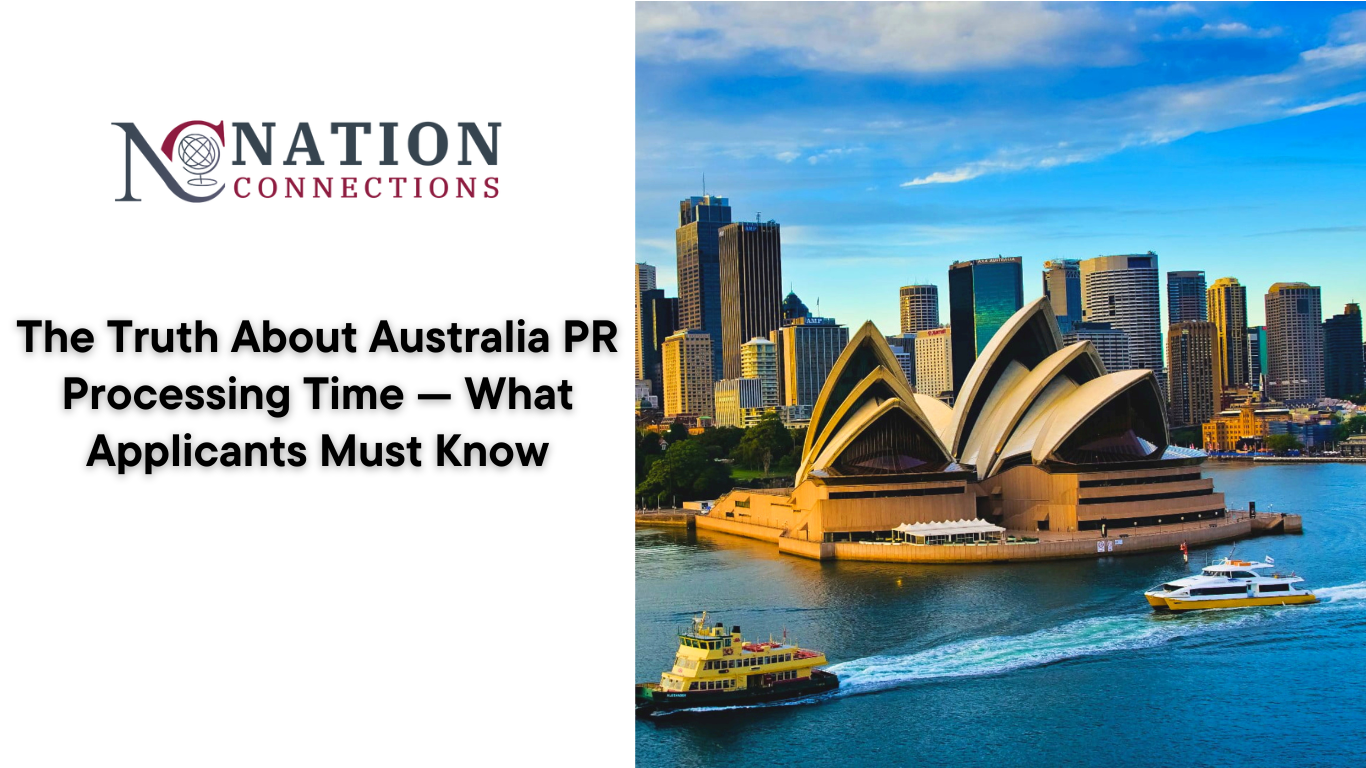
If you’re planning to apply for permanent residency in Australia — the coveted “Australia PR” status — you’re very likely thinking: How long will it take? The answer is: it depends. While many guides quote a few months, there are several hidden variables that can stretch the timeline — sometimes significantly. In this post we will peel back the layers on Australia PR processing time, explore the main influencing factors, share what official data says, what real applicants experience, and provide smart tips so you’ll go in with realistic expectations and a smoother journey ahead.
According to the Department of Home Affairs (DHA) site, global visa and citizenship processing times are published monthly and provide an indicative timeframe for finalisation of visa applications.
For example:
Many sources indicate that for the points-tested skilled visa route such as Subclass 189 (Skilled Independent) the processing time is estimated around 8-9 months as of 2025.
For Subclass 190 (Skilled Nominated) visa, some estimates put processing around 6.5-8 months.
A more general breakdown puts many permanent visa processing timelines “from 9 to 18 months”, depending on subclass and circumstances.
Importantly: In the most recent data, only about 53.42% of permanent visas were finalised within 12 months of lodgement.
So yes, you’ll often see numbers like “6-8 months” floating around — but those are averages or estimates for typical cases. Many applicants fall into longer-tail scenarios.
Understanding the variables is key to setting realistic expectations. Some of the major factors include:
If you lodge a decision-ready application — i.e., all documents, certified translations (if needed), English tests, skills assessments, health/character checks — your application can move relatively quickly. On the other hand, if documents are missing, incorrect or delayed, your processing time will increase.
Different PR pathways have different criteria and processing frameworks. A skilled independent subclass will differ from employer-sponsored routes, partner/family routes or regional routes. Each has its own queue, nomination requirements (if applicable) and paperwork.
For skilled visas, the occupation you nominate (via ANZSCO code), how in-demand it is, your points score, and whether you require a state/territory nomination can all affect how soon you get an Invitation to Apply (if applicable) and ultimately how fast your visa is processed.
Australia takes health, character and security assessments seriously. Delays in getting police clearances from overseas, or needing further medical tests, will add to your timeline.
The DHA processing capacity is impacted by how many applications are lodged, policy shifts, and seasonal/operational bottlenecks. For example, massive volumes in certain streams can lead to longer wait times.
It’s always useful to see what actual applicants report. On forums such as Reddit in the /r/AusVisa community, you’ll see quotes like:
“2.5 years… Came Feb 2013 … got my RN registration May 2015 … EOI Sept 2015 … PR granted Oct 2015.”
“Almost exactly 6 years…”
These highlight that while many may complete in under a year, for others the process can stretch to multiple years depending on their pathway and complexity.
While the “6-9 months” or “9-18 months” benchmarks are useful, you should prepare for scenarios where your wait could be considerably longer. Some reasons:
If you apply under a family route with large backlog (e.g., parent visas) the wait may extend to multiple years or even decades. (E.g., delays of up to 14–31 years have been reported in certain parent-visa categories).
If your subclass is capped or queue-based.
If you change occupation/nominator/conditions mid-application.
If you lodge incomplete data or delays happen in your medical/police clearances.
If policy-driven priorities shift (e.g., the government may prioritise certain skill streams or regional migration).
Here are practical things you should keep in mind:
Don’t book life-plans around a fixed date. Because your processing time could stretch, you should avoid making irreversible commitments (e.g., resigning a job overseas) unless your visa is granted.
Aim for a decision-ready application. The fewer outstanding items after you lodge, the better your chances of a smoother timeline.
Keep all documents valid. English test results, skills assessments, police checks — many have a validity period. If they expire before your application is finalised, you might need to redo them.
Monitor the official site for subclass-specific processing benchmarks. The DHA site publishes indicative processing times monthly.
Understand the first entry / travel date rule (if applicable). Your PR grant will include a “first entry date” by which you must enter Australia. Delays in lodgement or delayed travel may affect this.
Budget for contingencies. More months of waiting may mean more cost (e.g., maintaining your existing visa, travel, living costs).
Consider professional help if your case is complex. Complexities like unusual occupation, nominator issues, partner/family migration, or health/character complexities can make it beneficial to engage a migration agent or lawyer.
Below is a table summarising key actions you can take to keep your Australia PR processing time as favourable as possible:
| Action | Why it helps |
|---|---|
| Submit all required documents at lodgement | Reduces “requests for further info” which pause your timeline |
| Ensure your skills assessment, English test, etc are up-to-date | Avoids invalid credentials which could trigger delays |
| Choose the right subclass & state nomination (if eligible) | Ensures you are not in a slower-moving queue than necessary |
| Respond promptly to any case-officer request | Delayed responses push your application back in the queue |
| Avoid lifestyle changes that could affect your eligibility | Changing jobs, career breaks or invalidating a component may cause review |
| Keep track of changes in migration policy or subclass definitions | Being caught off-guard by policy changes can add unexpected delays |
“Processing time begins when I lodge my EOI”: Not always. For skilled visas, the time from Expression of Interest (EOI) to Invitation can itself vary and is separate from the formal visa processing time once you apply. Some estimates don’t account for this stage.
“6-8 months means I’ll definitely have it in 6-8 months”: No — that is a benchmark for simpler cases; your actual time could be shorter or much longer depending on variables.
“Everyone is delayed equally”: Actually, cases with more straightforward credentials, high points, in-demand occupations, and complete documents tend to move faster.
“Once my visa is lodged I can travel freely”: Until your visa is granted, you may still be on a provisional or bridging status. Travel or employment assumptions should be cautious.
“My occupation is on the list; so it will be quick”: While being on the list is a positive, the nomination, points score, documentation, and other checks still apply and can lengthen time.
For regional and provisional skilled visas (e.g., Subclass 491) the journey to full PR may include first a provisional visa. Some sources put the processing time for this type as “12-14 months”.
Employer-sponsored and business/migration nomination pathways often have additional steps (nominator verification, labor market testing, state endorsement) and therefore may take 12-18 months or more, especially under heavy volume.
With Australia’s migration program planning levels for 2025-26 remaining at around 185,000 places, competition remains high and the pressure on processing capacity will persist.
Policy shifts (for instance favouring regional migration, or changing occupation lists) may change which subclasses or occupations move faster or slower.
Technological and procedural improvements (e.g., better digital lodgement, improved document verification) may help speed up some streams — but they won’t eliminate variable delays overnight.
The truth about Australia PR processing time is that there is no one-size-fits-all answer. While many applicants may complete their visa in under a year (especially straightforward skilled-independent cases), there are plenty of cases where the wait extends to 18 months or more — and in some categories, several years. The key is to go in with your eyes open: choose the right subclass, submit a decision-ready application, keep documents valid and complete, and prepare for some waiting. By doing so, you’ll maximise your chance of a smooth path and avoid nasty surprises.
How long does it usually take to get Australia PR?
Typical reported timelines for skilled independent visas hover around 8-9 months; however, many applicants wait longer depending on subclass and individual case circumstances.
Why has my PR application been taking so long?
Delays often stem from incomplete documentation, low points/slow nomination, health/character clearances, high application volumes, or a subclass that has long waiting queues.
Does lodging my application guarantee the processing time quoted?
No. The published processing times are indicative for many cases, but your case may fall outside the faster group if there’re complexities or missing items.
Can I speed up the processing of Australia PR?
You cannot generally “fast-track” your application in the sense of bypassing requirements. But you can speed things by submitting a complete and accurate application, responding promptly to requests, and ensuring your credentials are ready.
What happens if my health or character check takes time?
If further tests or overseas police clearances are needed, your processing will pause until those are resolved. That add-on time is often outside your control.
Is there a risk I’ll wait years for PR?
Yes — especially in certain categories such as family/parent visas or quotas in certain streams, waiting for years (even a decade or more) has been documented.
Applying for PR in Australia is a major life decision and deserves a realistic understanding of how long the journey might take. By recognising the many factors that influence processing time, preparing thoroughly, and managing expectations, you give yourself the best shot. The path may require patience, but the destination — permanent residency in Australia — is worth planning for carefully.



